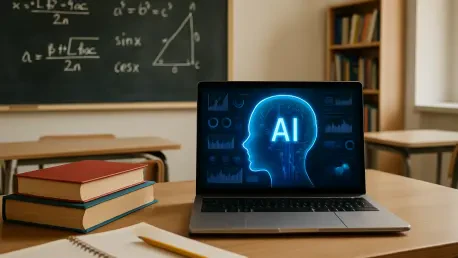Artificial Intelligence (AI) is rapidly becoming a cornerstone of modern education, presenting a remarkable opportunity to reshape how students learn and prepare for their futures while simultaneously introducing complex hurdles that cannot be ignored. As schools and universities across the globe integrate AI tools into their systems, the promise of personalized learning, enhanced accessibility, and career readiness shines brightly, offering a vision of education that adapts to individual needs in ways previously unimaginable. Yet, this technological leap forward comes with significant concerns, including the risk of overdependence, ethical dilemmas, and technical shortcomings that could undermine the very goals AI aims to achieve. The dual nature of AI as both a transformative force and a potential obstacle demands a closer examination of its impact. This article delves into the profound benefits AI brings to educational environments, while also addressing the critical challenges that must be navigated to ensure technology serves as a true ally in the pursuit of knowledge.
Revolutionizing Learning Through Personalization
The advent of AI in education has ushered in an era of personalized learning that could fundamentally change how students engage with material, addressing individual needs in ways traditional classrooms often struggle to match. AI platforms excel at analyzing a student’s unique strengths and weaknesses, crafting customized lesson plans that adapt to specific learning styles, whether visual, auditory, or kinesthetic. This tailored approach allows students to dive deeper into concepts, fostering genuine understanding over rote memorization for exams. By adjusting the pace and complexity of lessons, AI ensures that no student is left behind or unchallenged, creating a more inclusive environment where diverse learners can flourish. The potential for such customization marks a significant departure from one-size-fits-all teaching methods, positioning AI as a powerful tool to elevate educational outcomes across varied demographics and learning preferences.
Moreover, the impact of personalized learning through AI extends beyond just academic content, offering students a chance to build confidence and autonomy in their educational journey. These systems provide real-time feedback, identifying areas for improvement and suggesting targeted resources to bridge knowledge gaps. For instance, a student struggling with algebra might receive additional practice problems tailored to their specific errors, while another excelling in literature could be challenged with advanced texts. This dynamic interaction not only keeps students engaged but also helps educators monitor progress more effectively, freeing them to focus on mentorship rather than repetitive instruction. While the benefits are clear, the success of this approach hinges on ensuring that technology complements human guidance rather than replacing it, maintaining the essential role of teachers in fostering critical thinking and emotional growth alongside AI-driven personalization.
Enhancing Career Skills and Accessibility
AI’s influence in education reaches far beyond the classroom, playing a pivotal role in equipping students with the skills needed for professional success in an increasingly competitive world. Tools powered by AI assist with practical tasks such as crafting resumes, simulating interview scenarios, and even offering networking tips based on industry trends. These resources empower students to take proactive steps toward their career goals, bridging the gap between academic learning and real-world application. By providing actionable insights and personalized guidance, AI helps demystify the job market, ensuring that students are better prepared to navigate their professional paths with confidence and clarity. This focus on career readiness represents a forward-thinking approach to education, aligning learning with the demands of modern workplaces.
Equally transformative is AI’s ability to enhance accessibility, breaking down barriers for students with disabilities and ensuring that education is truly inclusive. Technologies such as text-to-speech and real-time transcription enable individuals who are deaf or visually impaired to engage with content on equal footing with their peers. These innovations remove longstanding obstacles, allowing access to lectures, readings, and discussions that might otherwise be out of reach. Furthermore, AI-driven assistive tools can adapt to specific needs, offering customized support that evolves with the user. The significance of this cannot be overstated, as it opens doors to educational opportunities for marginalized groups, fostering a learning environment where everyone has the chance to succeed. Such advancements underscore AI’s potential to create a more equitable educational landscape, provided they are implemented with care and consideration.
Navigating the Perils of Overdependence
While AI offers undeniable advantages, the risk of overreliance poses a serious threat to the development of essential skills that form the bedrock of education. When students turn to AI for quick answers or complete solutions, there’s a danger that critical thinking and creativity—cornerstones of intellectual growth—may be diminished. This phenomenon, often referred to as cognitive offloading, can turn a helpful tool into a crutch, preventing learners from honing the independent reasoning necessary for solving complex problems. Educators and experts emphasize that without a balanced approach, the long-term consequences could be detrimental, leaving students ill-equipped to tackle challenges that require original thought or nuanced analysis. The challenge lies in integrating AI in a way that supports rather than supplants personal effort.
Addressing this issue requires a shift in perspective, where AI is viewed as a partner in learning rather than a substitute for it, ensuring that students remain active participants in their education. Schools must prioritize teaching digital literacy alongside AI usage, helping students understand when and how to leverage these tools without surrendering their own analytical abilities. For example, assignments could be designed to encourage problem-solving processes that AI can assist with but not fully resolve, prompting students to engage deeply with material. Additionally, fostering a culture of curiosity and resilience can counteract the temptation to rely solely on technology. The goal is to strike a harmonious balance, where AI enhances learning without eroding the fundamental skills needed for academic and personal growth, a task that demands vigilance from both educators and learners alike.
Confronting Ethical Issues in Academic Integrity
The integration of AI into education also brings to light pressing ethical concerns, particularly around the issue of academic integrity, which remains a cornerstone of fair learning environments. With AI capable of generating essays, solving complex problems, or completing assignments in mere seconds, the temptation for students to bypass authentic effort is a growing problem. Such misuse not only undermines the value of education but also creates an uneven playing field, disadvantaging those who adhere to principles of honesty. Institutions are racing to update plagiarism policies and deploy detection tools to curb these violations, yet the ethical burden ultimately rests with students to use AI as a support mechanism rather than a shortcut. This dilemma highlights the need for clear guidelines on responsible usage.
Beyond policy updates, fostering a culture of integrity is essential to address these ethical challenges, ensuring that AI serves as an aid rather than a means of deception in educational settings. Educators can play a key role by integrating discussions about ethics into curricula, helping students understand the long-term consequences of academic dishonesty on their personal and professional lives. Workshops or modules on responsible AI use could provide practical strategies for leveraging technology without crossing ethical lines. Additionally, emphasizing the intrinsic value of learning over grades might reduce the incentive to misuse AI tools. The path forward requires a collective effort to instill values of fairness and accountability, ensuring that the benefits of AI do not come at the cost of compromising the principles that underpin education as a whole.
Addressing Technical Shortcomings with Caution
One of the less discussed but equally critical challenges of AI in education lies in its technical limitations, which can undermine trust in these systems if not properly managed. A notable issue is the phenomenon of “hallucinations,” where AI generates incorrect or entirely fabricated information due to flawed data or incomplete sources. This poses a significant risk in academic settings, where accuracy is paramount, as students and educators might inadvertently propagate misinformation if they fail to verify outputs. The reliability of AI is not guaranteed, and this shortcoming serves as a reminder that technology, no matter how advanced, is not infallible. Constant scrutiny and fact-checking are necessary to maintain the integrity of information derived from AI tools.
To mitigate these technical risks, a proactive approach centered on vigilance and education about AI’s limitations is essential for ensuring its safe integration into learning environments. Students and educators alike must be trained to cross-check AI-generated content against credible sources, developing a habit of skepticism toward unverified outputs. Institutions could implement protocols for validating information, perhaps integrating AI literacy programs that teach users how to spot potential errors or biases in responses. Moreover, developers of educational AI tools should prioritize transparency about data sources and algorithms to build trust among users. By fostering an environment of critical engagement with technology, the educational community can harness AI’s strengths while safeguarding against its weaknesses, ensuring that inaccuracies do not derail the learning process.
Charting a Balanced Path Forward
Reflecting on the journey of AI in education, it’s evident that the technology has sparked both remarkable progress and notable concerns within academic circles. Its capacity to personalize learning, boost career preparation, and enhance accessibility has opened new doors for countless students, reshaping traditional educational models. At the same time, the risks of overreliance, ethical breaches, and technical flaws have prompted serious debates about its unchecked use. Looking ahead, the focus should shift toward actionable strategies that maximize AI’s potential while minimizing its drawbacks. Developing robust ethical frameworks, investing in AI literacy programs, and encouraging ongoing dialogue between educators, students, and technologists can pave the way for responsible integration. By prioritizing balance and vigilance, the educational landscape can evolve to embrace AI as a partner in learning, ensuring that technology amplifies human potential rather than diminishing it.









